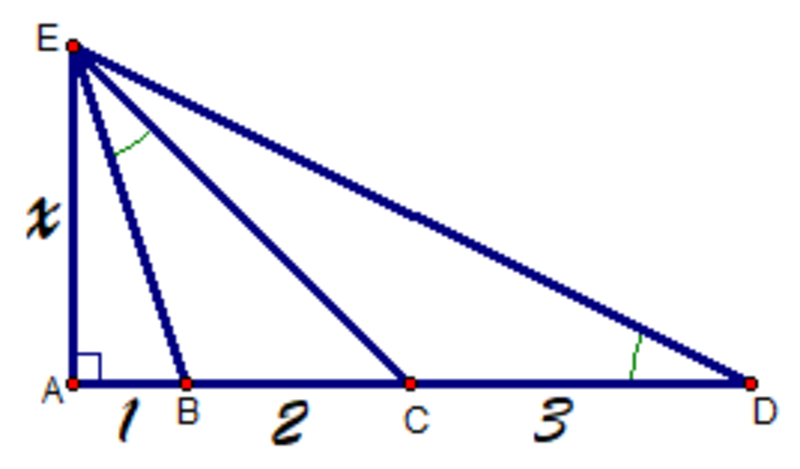Equal angles within a right triangle

Given that △ E A D has ∠ A = 9 0 ∘ , points B and C are on A D such that A B = 1 , B C = 2 , C D = 3 and ∠ A D E = ∠ B E C .
Find x = A E .
The answer is 3.
This section requires Javascript.
You are seeing this because something didn't load right. We suggest you, (a) try
refreshing the page, (b) enabling javascript if it is disabled on your browser and,
finally, (c)
loading the
non-javascript version of this page
. We're sorry about the hassle.
2 solutions
Let ∠ A E B = α and ∠ B E C = ∠ A D E = β . Then tan α = x 1 , tan ( α + β ) = x 3 and tan β = 6 x . Using the identity tan ( α + β ) = 1 − tan α tan β tan α + tan β , we get x = 3
Highly brillant , best approach to avoid lengthy equations .
Let ∠ A D E = ∠ B E C = θ . Then tan θ = tan ∠ A D E = 6 x ⟹ sin θ = x + 6 2 x . Since △ B E C and △ E A D has the same height x , the ratio of their area is given by:
[ E A D ] [ B E C ] 3 [ B E C ] 3 × 2 1 × B E × C E × sin θ 3 × x 2 + 1 2 × x 2 + 3 2 × x 2 + 6 2 x ( x 2 + 1 ) ( x 2 + 9 ) x 4 + 1 0 x 2 + 9 x 4 + 6 x 2 − 1 3 5 ( x 2 − 9 ) ( x 2 + 1 5 ) ⟹ x 2 x = A D B C = 6 2 = 3 1 = [ E A D ] = 2 1 × A D × A E = 6 x = 2 x 2 + 3 6 = 4 x 2 + 1 4 4 = 0 = 0 = 9 = 3 Since x 2 > 0